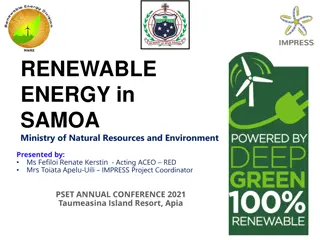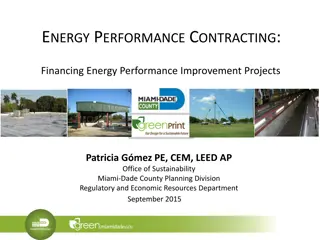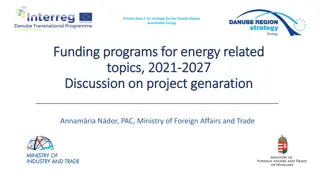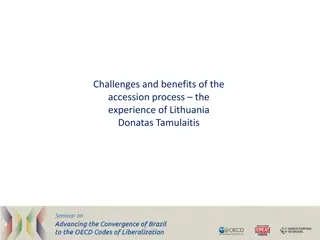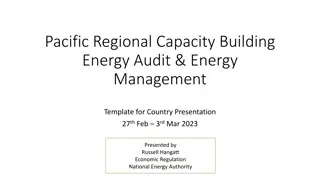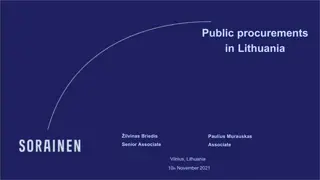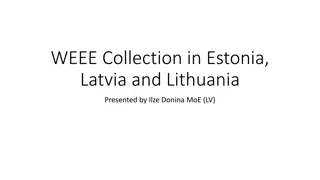Sustainable Energy Initiatives at Local Level in Lithuania
The National Parliamentary Workshop on Energy Efficiency highlighted the importance of renewable energy development and sustainability at the local level in Lithuania. Initiatives such as the Breakthrough package and Renewable Energy Communities aim to improve energy efficiency, reduce energy poverty, and promote green energy adoption. The Assessment of Sustainable Energy Development in Municipalities provides a comprehensive framework for evaluating progress in energy efficiency and renewable energy projects. Challenges faced by energy communities include funding, infrastructure development, and regulatory issues.
Download Presentation

Please find below an Image/Link to download the presentation.
The content on the website is provided AS IS for your information and personal use only. It may not be sold, licensed, or shared on other websites without obtaining consent from the author. Download presentation by click this link. If you encounter any issues during the download, it is possible that the publisher has removed the file from their server.
E N D
Presentation Transcript
NATIONAL PARLIAMENTARY WORKSHOP ENERGY EFFICIENCY AT LOCAL LEVEL Mayor of Elektrenai, Vice-Chair of ALAL Housing and Energy Committee Gediminas RATKEVI IUS 12 April 2024
ENERGY EFFICIENCY IMPROVEMENT AT LOCAL LEVEL 2022 m. Breakthrough package ( Prover io paketas ) Energy efficiency at local level: 7 GW from renewables by 2030 from renewables by 2030 Local Renewable Energy Development Action Plans 1 billion to green energy and energy to green energy and energy efficiency by 203 efficiency by 2030 0 11-80%share of RES of total energy share of RES of total energy consumption consumption in in different different municipalities municipalities
ASSESSMENT OF SUSTAINABLE ENERGY DEVELOPMENT IN MUNICIPALITIES Criterion Max points Energy efficiency at local level: 1. Renewable Energy Development Action Plan 8 2. Wind power installations of producers 11 3. Solar power installations of producers 10 4. Power of installations of producing consumers 9 5. Real estate tax on RES power plants 4 6. Share of renovated multi-apartment buildings 20 7. Average heating price 8 8. Length of cycling paths 6 9. Number of electric cars 5 10. Number of elektric cars charging stations 6 11. Funded projects 9 12. Energy poverty 4 Source Source: Lithuanian : Lithuanian Energy Energy Agency Agency
RENEWABLE ENERGY COMMUNITIES and CITIZEN ENERGY COMMUNITIES Communities oriented to energy poverty reduction 206,64 mln from State budget for financialinstrument Founders/stakeholders: municipalities institutions and municipalcompanies What is funded? Installation of solar or wind power plants or purchasing of remote renewable energy park At least 30 % of generated power to people on social allowances At least 1 kW per person facing energy poverty Funding: up to 50 % grant + soft loan (up to 3% interest rate and up to 15 years loan term) and/or municipal 70 % At least 30 %
ENERGY COMMUNITIES - CHALLENGES Soft Soft loan Electricity Electricity demand transmission transmission network No No proper proper plots Additional Additional costs Municipality Municipality- -controlled Communities Communities only loan will will be demand of of potential network in in that plots of of land land costs to to municipalities municipalities in in relation controlled companies companies can t only in in Citizen Citizen Energy be included included into into municipal municipal debt potential energy energy community that municipality municipality debt limits community is is higher limits higher than than free free power power of of to new new establishments establishments be stakeholders stakeholders in in Renewable Energy Communities relation to can t be Communities Renewable Energy Energy
RESULTS OF SURVEY IN MUNICIPALITIES Survey was carried out by INVEGA in 2023: Plans of municipalities to use financial instrument for establishment of Energy Communities 73 MW overall need of power capacity indicated by 37 municipalities which took part in a survey 18 12 municipalities are planning to establish energy community without cooperation and other 12 in cooperation with other municipalities 23 Readiness for this project of most municiaplities is at basic level 13 Project implementation limitations due to the municipal debt limits and complicated administration of the project due to the changing situation of deprived persons 6 Planning to apply Don't know yet Not planning to apply Didn't answer
BUILDINGS RENOVATION Implemented projects EU EU building building stock and 36 % of CO2 emissions. and 36 % of CO2 emissions. stock accounts accounts for for 40% of 40% of energy energy consumption consumption 900 800 769 In In 2020 2020 Europ strategy which aims to at least double the annual energy strategy which aims to at least double the annual energy renovation rate by 2030 renovation rate by 2030. . European ean Commission adopted a Renovation Wave Commission adopted a Renovation Wave 700 Renova Renovation buildings per year i buildings per year is s the as well. as well. tion Wave Wave 1 000 1 000 renov the the the goal of Lithuanian Government goal of Lithuanian Government renovated ated multi multi- -apartment apartment 574 600 500 403 398 Multi Multi- -apartment buildings in Lithuania account for 54% of apartment buildings in Lithuania account for 54% of total energy consumption. total energy consumption. 400 344 304 278 300 269 224 In In 2013 2013 new renovation model introduced in Lithuania new renovation model introduced in Lithuania putting municipalities at a central role putting municipalities at a central role. . 200 123 100 41 Less than 500 Less than 500 buildings renovated in the period of 2005-2013 More than 4500 More than 4500 contracts for renovation at the moment More than 3700 More than 3700 projects within 10 years (2013 2023) 0
RENOVATION CHALLENGES (1) Funding Lack Lack of of loan loan providers providers in in the the process process. . Due Due to for for renovation renovation projects of of construction construction works years, years, hous housing growing growing financial financial burden to the the constantly constantly i increasing projects and works and ing renovation renovation is is becoming burden for for residents ncreasing requirements requirements and the the increased increased prices and materials materials in in recent becoming a a residents. . prices recent Funding Funding problems problems biggest in in implementation implementation of and and new new projects projects. . biggest bottleneck bottleneck of already already approved approved Changes Changes in in terms loans loans for for renovation renovation. . terms of of providing providing soft soft
RENOVATION - CHALLENGES (2) Renovation using prefabricated modular panels Lack Lack of of accurate accurate information information. . No No legal legal framework framework in in place place. . Pilot Pilot projects projects not not implemented implemented yet yet. . renovation. . More More expensive expensive than than regular regular renovation
RENOVATION CHALLENGES (3) A class renovation. Excessive requirements? From 2022 amendments in regulation - more stringet requirements for state compensation (30 % of investment on certain energy-efficiency measures). It is planned to further tighten the requirements for the energy class of renovated buildings leaving only A class. At the moment call only for A class renovation. B class renovation call only using prefabricated modular panels. Increased renovation costs, not attractive for residents preventing them to take decision for renovation Lack of skilled and reliable construction companies in renovation process.
CONCLUSIONS In order to achieve tangible results in energy efficiency and other green goals, it is necessary: A A clear Sustainable Sustainable funding S Stable table legal legal framework Close Close cooperation cooperation at at all clear long long- -term funding. . framework and term perspective perspective. . and regulation regulation. . all levels levels. .
Thankyou for your attention!








